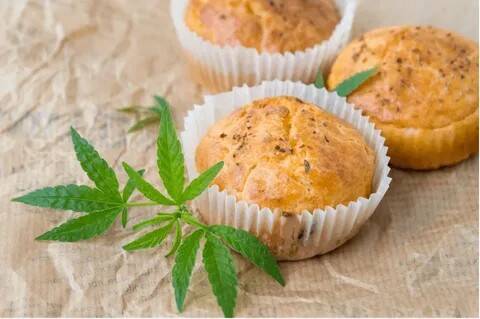
Making weed edibles at home can be a fun and rewarding way to enjoy the benefits of cannabis. Here’s a step-by-step guide to help you get started:
Understand the basics:
Understanding the basics of making weed edibles at home is crucial for a successful and enjoyable experience. Here are some key points to consider:
- Know your cannabinoids: Cannabis contains various cannabinoids, including THC and CBD, which have different effects. THC is responsible for the psychoactive effects, while CBD offers potential therapeutic benefits without the high. Understand the cannabinoid profile of your cannabis strain or concentrate to determine the desired effects.
- Decarboxylation: Decarboxylation is the process of activating the cannabinoids in cannabis through heat. Raw cannabis contains mostly THCA and CBDA, which are non-psychoactive. Decarboxylation converts these compounds into THC and CBD, making them bioavailable. This step is essential before infusing cannabis into edibles.
- Infusion methods: There are several infusion methods to choose from, depending on your preferences and equipment. Common methods include:
- Stovetop infusion: Simmering cannabis in butter or oil on low heat for an extended period.
- Slow cooker infusion: Combining cannabis and fat in a slow cooker and cooking on low for several hours.
- Sous vide infusion: Using a water bath and vacuum-sealed bags to infuse cannabis into fat with precise temperature control.
- Infusion devices: Some specialized devices are designed specifically for cannabis https://gg4.store/product-category/edibles/ infusion, offering convenience and control over the process.
- Dosage calculations: Determining the appropriate dosage is crucial for a safe and enjoyable experience. Start with a low dose, especially if you’re new to edibles or unsure of your tolerance. Consider factors such as the THC potency of your cannabis, the infusion ratio, and the number of servings to calculate the desired dosage per serving.
- Safety precautions: When making weed edibles, it’s important to take safety precautions to prevent accidental ingestion, especially by children or pets. Store cannabis and infused products in a secure, labeled container, and keep them out of reach. Clearly label any homemade edibles with the presence of cannabis to avoid confusion.
Choose your recipe:
Choosing the right recipe is an important step when making weed edibles at home. Here’s a guide to help you select a recipe that suits your preferences and skill level:
- Consider your experience level: If you’re a beginner, it’s best to start with simple recipes that don’t require complex techniques or equipment. As you gain more experience, you can explore more advanced recipes.
- Decide on the type of edible: There are endless options for weed-infused edibles, ranging from sweet treats like brownies, cookies, and gummies, to savory dishes like infused oils, butters, and even pasta sauces. Consider your personal preferences and choose a recipe that appeals to you.
- Review the recipe ingredients: Look for a recipe that lists ingredients you’re comfortable working with. Take note of any additional ingredients required for cannabis infusion, such as butter, oil, or tinctures. Ensure you have everything you need before starting.
- Check the dosage: If the recipe doesn’t specify the desired dosage, you’ll need to calculate it based on the potency of your cannabis and the desired strength of the edibles. Keep in mind that homemade edibles may have varying potencies, so it’s essential to start with a low dose and gradually increase if needed.
- Consider the cooking process: Some recipes may require specific cooking techniques, temperatures, or equipment. Make sure you have the necessary tools and are comfortable following the instructions provided. If you’re a beginner, opt for recipes with straightforward cooking methods.
Gather your ingredients:
Gathering the right ingredients is a crucial step when making weed edibles at home. Here’s a guide to help you get started:
- Cannabis: Choose a strain that aligns with your desired effects. Consider the THC and CBD levels to determine the potency. You can use either dried flower or cannabis concentrates like hash, kief, or oil, depending on your preference.
- Fat or oil: THC and other cannabinoids are fat-soluble, so you’ll need a fat or oil to infuse them into. Common choices include butter, coconut oil, olive oil, or vegetable oil. Choose a high-quality, unsalted butter or a neutral-flavored oil for best results.
- Additional ingredients: Depending on your chosen recipe, gather the ingredients required for the specific edibles you want to make. This may include flour, sugar, eggs, chocolate, vanilla extract, or any other ingredients listed in the recipe.
- Tools and equipment: Ensure you have the necessary tools and equipment for the recipe. This may include a saucepan or double boiler for infusing, a baking sheet or cake pans for baking, mixing bowls, measuring cups and spoons, a whisk or spatula, and an oven or stovetop.
- Optional flavorings: If desired, gather any additional flavorings or extracts that complement the flavors of your chosen recipe. This can include vanilla extract, cocoa powder, spices, or extracts like mint, lemon, or almond.

Decarboxylate your cannabis:
Decarboxylation is a crucial step in the process of making weed edibles at home. It involves heating cannabis to activate the cannabinoids, particularly THC and CBD, by converting the non-psychoactive THCA and CBDA into their active forms. Here’s a guide to help you decarboxylate your cannabis:
- Preheat your oven: Preheat your oven to around 220-240°F (105-115°C). This temperature range is optimal for decarboxylation without degrading the cannabinoids.
- Prepare your cannabis: Break up your cannabis buds into smaller pieces, ensuring they are evenly sized. You can use a grinder or your hands to do this. Avoid grinding the cannabis too finely, as it may make it more challenging to strain later.
- Spread the cannabis: Place the broken-up cannabis buds on a baking sheet lined with parchment paper. Ensure that the buds are spread out in a single layer. This allows for even heating and decarboxylation.
- Bake the cannabis: Place the baking sheet with the cannabis in the preheated oven. Bake for approximately 30-45 minutes. The exact time may vary depending on your oven and the moisture content of the cannabis.
- Monitor the process: Keep an eye on the cannabis while it’s baking. You’ll notice that the buds will become slightly darker and may emit a noticeable aroma. Be careful not to overcook or burn the cannabis, as this can degrade the cannabinoids and affect the flavor.
Infuse cannabis into butter or oil:
Infusing cannabis into butter or oil is a crucial step in making weed edibles at home. It allows you to extract the cannabinoids from the cannabis and incorporate them into a fat or oil base for use in various recipes. Here’s a guide to help you infuse cannabis into butter or oil:
- Choose your fat or oil: Select a high-quality fat or oil as your infusion base. Common choices include unsalted butter, coconut oil, olive oil, or vegetable oil. Consider the flavor profile and stability of the fat or oil when making your selection.
- Decarboxylate your cannabis: Prior to infusion, decarboxylate your cannabis to activate the cannabinoids. Follow the decarboxylation process outlined earlier in this guide.
- Grind or chop the cannabis: Once your decarboxylated cannabis has cooled, grind or chop it into smaller pieces. You can use a grinder, blender, or chop it by hand. Avoid grinding it too finely, as it may make it more challenging to strain later.
- Heat the fat or oil: In a saucepan or double boiler, heat the chosen fat or oil on low to medium heat. It’s important to heat it gently and avoid boiling or overheating, as it can degrade the cannabinoids.
- Add the cannabis: Add the ground or chopped cannabis to the heated fat or oil and stir well to ensure all the cannabis is coated and immersed in the mixture. Maintain a low heat and stir occasionally to prevent burning or sticking.
Strain the infused butter or oil:
Straining the infused butter or oil is an essential step when making weed edibles at home. It helps remove the plant material and ensures a smooth and clean final product. Here’s a guide to help you strain the infused butter or oil:
- Prepare the straining materials: Get a fine mesh strainer, cheesecloth, or a nut milk bag. Make sure it is clean and free of any debris or residue.
- Set up the straining apparatus: Place the strainer over a clean bowl or container large enough to hold the infused butter or oil. If using cheesecloth or a nut milk bag, line the strainer with it, leaving enough overhang to easily gather and squeeze the plant material.
- Pour the infused mixture: Carefully pour the infused butter or oil into the strainer, allowing it to flow through into the bowl or container. Take your time to ensure you don’t spill or splash the mixture.
- Strain the mixture: Use the back of a spoon or a spatula to press down on the plant material in the strainer, extracting as much of the infused liquid as possible. If using cheesecloth or a nut milk bag, gather the edges and twist them tightly, squeezing out the remaining liquid.
- Repeat if necessary: If you notice any plant material or sediment in the strained liquid, you may want to strain it again using a fresh strainer or a finer mesh cloth. This step helps ensure a smoother final product.
- Store the strained infusion: Transfer the strained infused butter or oil into a clean, airtight container. Label it clearly with the date and potency, and store it in the refrigerator or a cool, dark place. Properly stored, it can typically last for several weeks.
Remember to handle the infused butter or oil with care and store it out of reach of children or pets. It’s important to note that the straining process may take some time and can be messy, so be patient and work carefully to achieve a clean and refined infusion.

0 Comments for “Guide to weed Edibles at home”